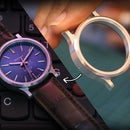Introduction: Watch Dial Using Printed Circuit Board (PCB) | DIY Mechanical Watch - Part 2
Hello and welcome back to another Instructables! I'm on an exciting journey to build a fully functional mechanical watch. After diving into the DIY build community, I realized it’s not as daunting as it seems, thanks to all the online resources. Instead of buying a pre-made kit, I decided to challenge myself by building the case and dial from scratch.
In my previous Instructables, I designed the watch case in Fusion 360 and had it CNC machined by PCBWay. Today, I will show you how I created the dial using a Printed Circuit Board (PCB) and assemble the entire watch. Let’s dive in!
Supplies
1x Watch Hands
1x 18mm watch strap
1x 28.75mm dia Round Watch Glass (front)
1x 25mm dia Round Watch Glass (back)
Step 1: Dial Design
The plan is to design the dial using a printed circuit board or PCB and make use of its elements (silkscreen, copper, etc) to build a watch face. I would be using Altium Designer to design the PCB. This software allows you to import 2D CAD files in DWG format onto any PCB layers. I began by designing the overall PCB layout in AutoCAD—a tool I’m well-versed in, thanks to my daily work. I used separate layers to represent the silkscreen, copper, and board outline elements.
I started by going through the datasheet of NH35A which has the dimensions of the dial needed to fit the movement correctly. The datasheet seems to be a good starting point for the design. Once I knew the location of the date & stem cutouts, I then moved on to the planning of the design.
I decided to use:
- Exposed copper - hour markings
- Silkscreen - seconds markings, text
- Unexposed copper - Circular pattern to give a textured look
After finalizing the design, I uploaded the Gerber files to PCBWay. Before you upload, make sure these specifications are selected:
- Board thickness: 0.4mm
- Minimum track/spacing: 4/4mil
- Soldermask: Black
- Remove product no.: Specify Location - This is important as you don't want order no. to appear on the watch face.
The PCB turned out well, with a slight shift in the silkscreen layer and some minor text distortion due to an uneven surface below. I added pads on the bottom side for soldering the dial feet, and now it’s time for the assembly. Check out my Altium 365 workspace if you wish to use this design. You can directly buy the PCBs from PCBWay from here.
Step 2: Assembly
I have gone over the process here in brief. There are plenty of videos or guides on the internet that show how to assemble a watch properly.
I added pads on the back of the dial to solder the dial feet. Unfortunately, I was unable to get my hands on those, so I proceeded without them.
Start by placing the dial on the movement and make sure to align the dial feet with the movement.
Attach your choice of watch hands to the movement.
Attach watch glass to the case body and case back. I used 28.5mm glass and it turned out to be very loose. With no choice, I resorted to clear epoxy. It seems like 28.75mm glass could be press-fitted.
Place the case body over the movement. Time to work on the bottom side.
Screw in the crown on the stem after cutting it to the correct size and insert the stem in place.
I am still working on the case back and for now, I am using a 3D printed one that snaps into place.
Step 3: Improvements
There are a lot!
Now that I have gotten a bit comfortable with designing and assembling the watch, I would like to build another one with features that I omitted now.
Add O-rings to the design to make it water-resistant
Use copper layers only as there are high chances of a shift in the silkscreen layer.
Make full use of the capabilities of a PCB (add electronics/LEDs?!)
Case back
Last but not least - dust free. Hate when I see specs of dust particles in the close-ups.





